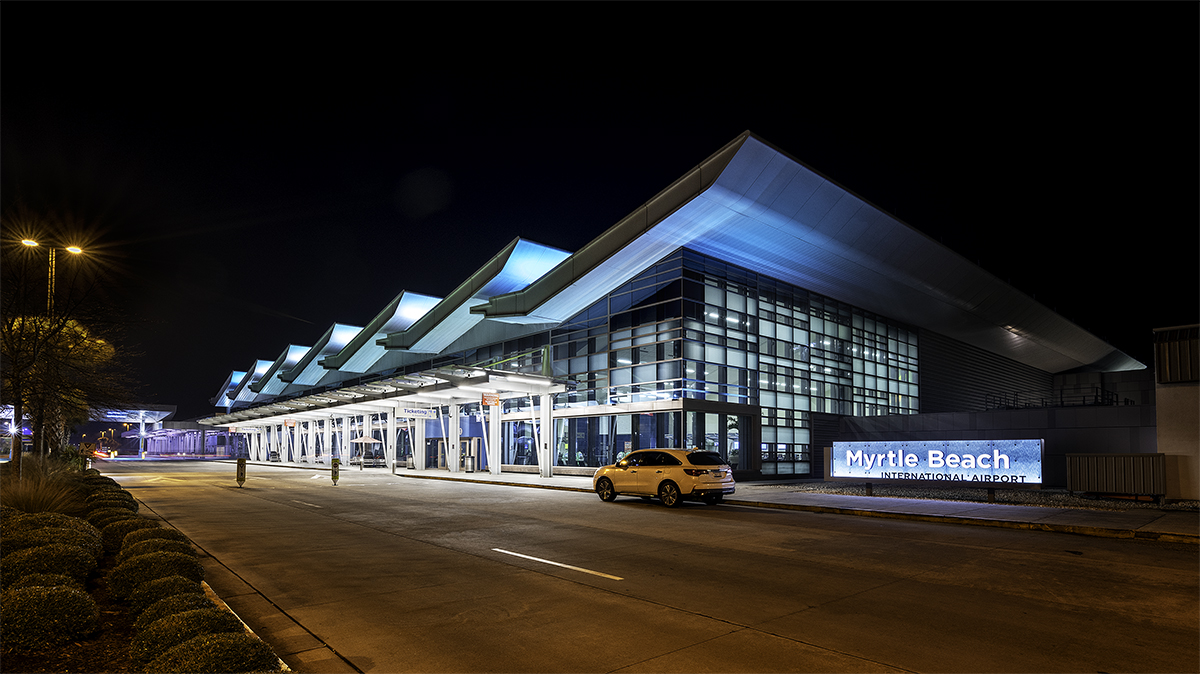Photographing Myrtle Beach International Airport – A Behind-the-Scenes Look at Capturing Its Architecture

There’s something exciting about airports. They’re places of movement, transition, and energy. They represent the beginning of a vacation, a new opportunity, or a return home. And from an architectural standpoint, they have to be incredibly functional and beautifully designed.
I recently had the opportunity to photograph the Myrtle Beach International Airport (MYR), both the exterior and interior, and it turned out to be one of the most interesting and rewarding projects I’ve worked on. Whether you’re an architect, interior designer, airport planner, or marketing director, I thought I’d take you behind the scenes to share what goes into capturing a space like this from an architectural photography perspective.
First Impressions of the Myrtle Beach International Airport Design
The Myrtle Beach International Airport (MYR) is more than just a travel hub—it’s a welcoming first impression of the Grand Strand for thousands of people each day. Right away, I was struck by how open and bright the architecture felt. There’s a lot of glass, natural light, and thoughtful design choices that make the space feel clean, modern, and connected to the coast.
From a photographer’s point of view, it’s the kind of space that invites you to slow down and take it all in—from the sweeping rooflines outside to the soft flow of natural light inside.
As soon as I arrived at the Myrtle Beach International Airport, I could tell this wasn’t just any transportation hub. The architecture feels light and welcoming, with wide-open spaces and tons of natural light pouring in from floor-to-ceiling windows. The design reflects the laid-back coastal vibe of the city it serves—clean lines, soft curves, and a palette that connects with the landscape.
From the very beginning, I knew the goal was to create images that didn’t just show the structure, but also communicated that feeling of openness and ease. Good airport design should feel effortless for travelers, and I wanted that to come through in the photographs.
Photographing the Exterior: Light, Lines, and Landscape

The exterior photography was all about timing and planning. Airports are massive, so capturing the full scale while highlighting design details takes a strategic approach.
I chose to shoot during both golden hour and blue hour—those quiet moments just after sunrise and just before nightfall when the light is soft, directional, and flattering.
Early morning gave me warm, golden light that accentuated the terminal’s form and surfaces, while blue hour created contrast between the illuminated interior and the cool tones of the sky.
The mix of steel, glass, and warm tones really came to life during those quiet, low-light moments.
I used tilt-shift lenses to keep vertical lines straight and clean (a must when photographing architecture) and framed the building from various distances to show how it fits into its environment. I also captured some tighter angles to highlight architectural materials, the main entrance, and areas where travelers interact with the space.
Each shot needed to feel intentional and composed, with the right balance between structure and surrounding landscape.
Photographing large structures like an airport means paying close attention to light, angles, and scale.
The goal was to highlight the airport’s structure while showing how it fits into the environment.
Interior Photography: Telling the Story of Movement and Calm

Once inside, it was all about capturing how the space feels and functions. The terminal is spacious and full of natural light, with a layout that flows really well. From ticketing areas to boarding gates and retail spaces, every zone had a sense of calm and clarity—which isn’t always easy to achieve in a busy public building.
I focused on capturing the interior architecture in a way that reflects how real people experience it: the openness, the movement, the light. I also made sure to highlight material choices and textures—like wood accents, ceiling panels, and the clean lines that guide you through the terminal.
Because it’s a space that’s always in motion, I timed my interior photography during quieter hours to minimize foot traffic and distractions. That way, the focus stays on the design itself.
One of the things that stood out to me was the abundance of natural light. The terminal’s large glass curtain walls allow daylight to flood in, making the space feel open and less stressful—something every traveler appreciates.
There are also beautiful material touches throughout—textured ceilings, sleek flooring, metal accents, and wood details that soften the overall aesthetic. I made sure to photograph wide, sweeping views that show how each space connects to the next, along with detail shots that celebrate craftsmanship and design intent.
Myrtle Beach International Airport - Telling the Story of the Space
For me, architectural photography isn’t just about documentation—it’s about storytelling. With the Myrtle Beach airport, the story is about arrival and departure, calm and motion, local identity and modern design. I wanted each image to reflect those ideas and help viewers really feel the space, not just see it.
There’s something powerful about capturing a moment of stillness in a place that’s built for constant movement.
Why Architecture Photography Matters in Spaces Like This

When photographing large public buildings like airports, it’s about more than just documenting the space. It’s about showing how the architecture supports the human experience. Does it feel intuitive? Is it visually calming? Does it reflect the spirit of the location?
For Myrtle Beach International Airport, the answers are yes across the board. The architecture captures a sense of place—it’s bright, clean, coastal, and functional. Through my lens, I wanted to tell that story: how design and experience come together to welcome thousands of travelers every day.
Photographing Myrtle Beach International Airport was one of those projects that reminded me why I love architectural photography. It’s not just about buildings—it’s about capturing the thought, planning, and purpose behind them. Airports, in particular, are places where architecture really matters. They shape how people feel, how they move, and how they experience a city for the first time.



